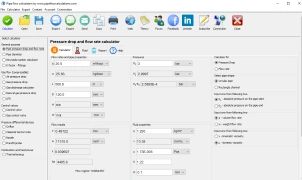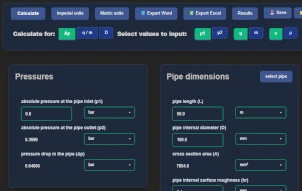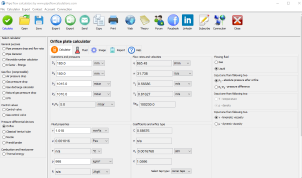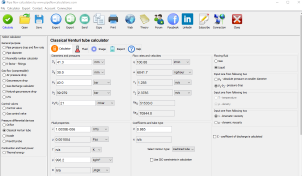Why should you use this calculator?
Nozzles and Venturi nozzles are devices that are inserted in circular cross-section
conduit to create a pressure difference of static pressure caused by the flow contraction
in the throat of it. You can calculate flow rate using that pressure difference.
Due to the contraction in the diameter from the inlet to the throat of the nozzle,
the flow velocity is changing while flow rate remains constant. That change in flow velocity
is creating the increase of the dynamic pressure and drop of the static pressure,
as total pressure remains uniform, according to the conservation law.
You can measure the change of the static pressure by measuring the pressure in the inlet
and after the nozzle. That measured value is the input value for the calculation of the flow rate.
This calculator also calculates total pressure drop created by the nozzle.
You can use this calculator for all three types of nozzles covered in standards:
ISA 1932 nozzle, long radius nozzle, and Venturi nozzle. All three types differ from each other based on its shape. All nozzles have radius shaped convergent inlet with the cylindrical throat, and Venturi nozzle also has a divergent part as an outlet.
When is this calculator suitable?
You can use a nozzle and Venturi nozzle calculator for subsonic single-phase liquids or
ideal gases. The calculator is not for pulsating flow, or non-steady flow when the flow rate
is changing in time.
When is this calculator not relevant?
This calculator is not suitable for flow of multiphase fluids,
like a stream of liquids that contain solid particles or stream of liquids that contain
undissolved gases. Also, it is not suitable for gases that are not ideal, i.e., gases
that don't relate to the perfect gas law.
Limiting factor for this calculator is when the flow reaches chocked flow and mean velocity
is close to the local speed of sound. You can use gas discharge calculator for
calculation of gas flow with a higher pressure drop and flow close or equal to choked flow
conditions.
What else has to be known to perform the calculation?
To calculate flow rate, you have to enter the nozzle inlet and throat diameter,
together with fluid properties - density and viscosity.
For a gas as flowing fluid, instead of the density, you can enter gas constant,
pressure and temperature at actual conditions. Density is then calculated using an
ideal gas state equation.
You should enter density on actual flow conditions, as well as real pressure and
real temperature.
How is the calculation performed?
The calculator is doing calculation according to ISO 5167-3.
You can expect to have accurate and reliable results solely if the device satisfies the
requirements from the standard.
What are the standard ISO 5137-3 conditions?
For the flow of a perfect gas, the pressure reduction produced by the nozzle (p2/p1) must be higher than 0.75.
Limits of use for nozzles are:
50 mm < D < 500 mm
0.3 < β < 0.8
7x104 < ReD < 107 for 0.3 < β < 0.44
2x104 < ReD < 107 for 0.44 < β < 0.80
Limits of use for long radius nozzles are:
50 mm < D < 630 mm
0.2 < β < 0.8
104 < ReD < 107
Limits of use for Venturi nozzles are:
65 mm < D < 500 mm
0.316 < β < 0.775
1.5x105 < ReD < 2x106
What happens if a calculation is not within these limits?
If the nozzle characteristics or flow conditions are not according to the ISO 5167-3
calculator presents the warning message. If you still want to perform calculation
regardless of the states in the standard, you can choose not to use ISO constraints
in the computation.







